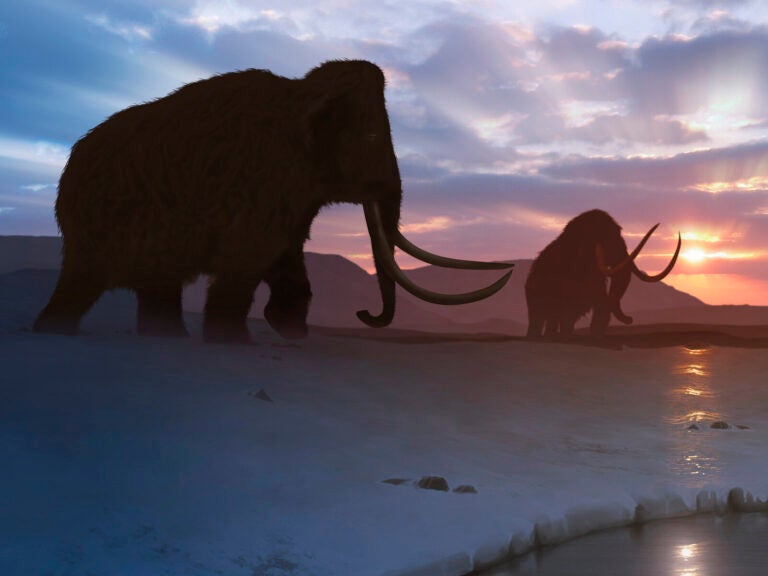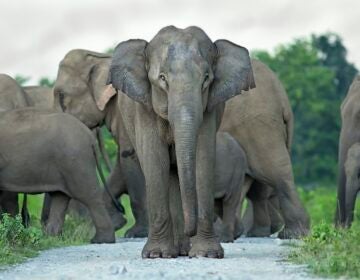Scientists take a step closer to resurrecting the woolly mammoth

Could woolly mammoths walk again among humans? Scientists are working to resurrect the extinct species. (Mark Garlick/Getty Images/Science Photo Library)
A biotech company that hopes to resurrect extinct species said Wednesday that it has reached an important milestone: the creation of a long-sought kind of stem cell for the closest living relative of the woolly mammoth.
“This is probably the most significant step in the early stages of this project,” said George Church, a geneticist at Harvard University and the Massachusetts Institute of Technology who co-founded Colossal Biosciences in Dallas.
The woolly mammoth was a big, shaggy species of elephant that roamed the tundra before going extinct thousands of years ago. Colossal has been working to bring the mammoth, the dodo bird and other extinct species back to life using the latest cloning and genetic engineering techniques.
And now the company says scientists have for the first time created induced pluripotent stem cells for the mammoth’s closest living relative: Asian elephants. The company plans to describe the work in a scientific paper that will be posted on the bioRxiv preprint server. It hasn’t been peer-reviewed, but the company says that’s in progress.
A steppingstone from modern elephant to mammoth
The achievement is still far from the ultimate goal of creating herds of giant hairy beasts roaming in the wild again, but Church said it’s a major step. “This is kind of like asking Neil Armstrong if he plans to go to Mars — kind of misses the point he just landed on the moon on Apollo 11,” Church said.
Scientists can now try to use cloning techniques and gene editing to manipulate the cells in the hopes of someday creating elephants with key traits of mammoths, such as their heavy coats and the layers of fat that enabled them to survive in cold climates.
“We don’t necessarily need to bring back a perfect genome of a mammoth, because we want one that has certain things that mammoths didn’t have. Like we want them to be resistant to the herpesvirus that is causing a huge fraction of infant elephants to die,” Church said.
Technical possibility raises ethical concerns
But some scientists object to the whole idea of trying to revive extinct animals.
“What are you going to get out of this?” asked Karl Flessa, a professor of geosciences at the University of Arizona. “First of all, I think you’re going to get a bit of a freak show in a zoo somewhere. And then if you’re going to release a herd into the Arctic tundra, is that herd going to go marching off to its second extinction in the face of global warming?”
“I think it’s irresponsible,” Flessa added.
But Church and his colleagues defended the project.
“Some people think it’s a bad idea because there will be only one lonely cold-adapted elephant. That’s not our intention,” Church said. “It’s to have them fully socialized in large herds. Some people think it’s a bad idea because it takes money away from conservation efforts, when in fact we’re injecting money into conservation efforts.”
Church said the woolly mammoth program could lead to new ways to protect endangered species like Asian elephants by expanding their habitat and helping scientists study the animals.
Researchers say the work will advance conservation
“We’re very, very excited that we have derived the first elephant induced pluripotent stem cells,” said Eriona Hysolli, who heads Colossal’s mammoth project. “These cells will benefit the elephant conservation community just as much as being engineered to bring back the woolly mammoth.”
Reintroducing elephants with woolly mammoth traits could also help fight global warming by restoring ecosystems in ways that would help reduce the amount of carbon being released into the atmosphere, Church said.
Some scientists say the creation of the specialized elephant stem cells is a noteworthy scientific achievement.
“Producing induced pluripotent stems has proved to be very difficult for some species — notoriously the elephant,” said Oliver Ryder, director of conservation genetics at the San Diego Zoo Wildlife Alliance. “It’s a great advancement to have been able to accomplish this for elephants.”
The cells can be used to study the biology, reproduction and health of elephants, he said.
“It opens up new possibilities for conserving species’ genetic diversity, preventing extinction and contributing to the sustainability of species,” Ryder said. “There’s an enormous potential.”
While that may be true, others argue that using the cells to try to bring back mammoths is misguided.
“What I find troubling is bringing back some sort of a surrogate that is part- mammoth, part-elephant,” said Joseph Bennett, an associate professor of biology at Carleton University in Ottawa, Canada. “Bringing that back as something that would somehow be portrayed as conservation would be a difficult sell on my part.”
Others agree.
“There are so many species going extinct today. We’re actually not going to be able to help any of them if we’re thinking about the woolly mammoth. We need to focus on the species here today. Living animals versus fossils is really where our focus should be,” said Gabriela Mastromonaco, senior director of wildlife science at the Toronto Zoo. “It’s just a distraction.”
9(MDAzMzI1ODY3MDEyMzkzOTE3NjIxNDg3MQ001))




